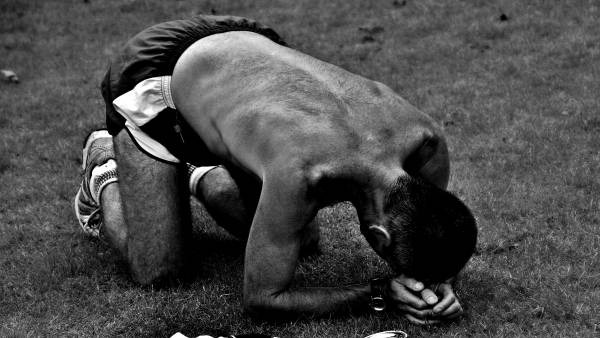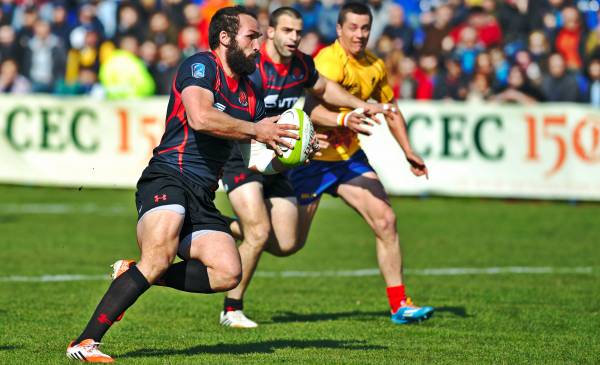Last time, we covered how to build your strength in rugby season. Now, let’s look at how to maintain your overall fitness. During the winter months, you are going to have games postponed due to the condition of the pitches. This can affect the amount of time you spend training and playing, and when you’re not covering your usual amount of miles on the field, our 80-minute engine can degenerate rapidly.
Rugby players have to couple sharp bursts of power with just as rapid recoveries.
In rugby, you have to mix bursts of power facilitated by the anaerobic energy system with quick recoveries using the aerobic energy system. A decent fitness programme for the sport should strike a good balance of anaerobic and aerobic training. My favourite way to develop these energy systems together is through interval training. I favour tempo training, maximal aerobic speed (MAS) training, and high intensity interval training (HIIT). Before we dive into our in-season fitness programme, you need to know a little more about the methods.
The Aerobic System
Aerobic system training isn’t particularly stressful on the central nervous system, and actually helps to improve your recovery. The principles in training this system are similar to sub-maximal principles in strength training. Here, you’ll mix tempo-based intervals with maximum aerobic speed (MAS) intervals.
Tempo Training Intervals
Tempo training intervals are a way of clocking up the metres without going flat out. You want to be going at around 60-70% of your maximal running speed, or a “comfortably hard” pace. You’ll be able to say some words, but not hold a conversation. In these intervals, you will be resting for longer than you work, so you shouldn’t ever be in a state of exhaustion.
For rugby, I suggest using 50m intervals as this is comparable to the distance you run in a game and the round number makes the maths easy. I also suggest using a rolling clock, starting your reps every 30 seconds at 00:00, 00:30, 01:00, 01:30, and so on. You should rest the remainder of the time. Depending on where you play, here’s what you should be aiming for 50m intervals in tempo work:
- Props – 11-12 seconds
- Locks – 10-11 seconds
- Hookers & Loose Forwards – 9-10 seconds
- Inside Backs – 9-10 seconds
- Outside Backs – 8-9 seconds
To get a more accurate pace for tempo training, time a max effort 50m sprint, then calculate your speed in metres per second from the result. For example:
- If the 50m took you 6 seconds, divide 50 by 6. This gives you a pace of 8.3 metres per second (m/s).
- To find the 70% you’re looking for tempo training, divide this figure by 0.7 (8.3 m/s / 0.7)
- This is your 50m pace for tempo training. In this example, it’s 11.8 m/s.
For those wanting an additional challenge, add change of direction work. These pitch-based runs equate to roughly 50m each.
- Try Line –> Near 22m –> Return to try line
- Try Line –> Dead Ball –> Near 10m line
- 10m Line –> Far 10 –> Return to other 10 –> Half Way
- Try Line –> 5 Meter line –> Dead Ball –> Near 22m
As a progression you could also include down ups, or increase some reps to 100m – just make sure to extend your rolling clock to 60 seconds on those reps.
Maximal Aerobic Speed (MAS) Intervals
MAS running is similar to tempo running in that they are both sub-maximal. In this case, the training is based on a 2.4km test time. So first, go for an all-out 2.4km run. This should be as hard as you can possibly go. If you’ve got enough breath to be chatting to someone else at the same time, you need to be working harder.
Then, calculate your MAS score for interval work.
- Take the total metres ran (in this case, 2400) and divide it by the total duration it took you in seconds. Let’s say it took you 10 minutes, or 600 seconds.
- 2400m divided by 600 seconds = 4 metres per second (m/s)
- 4 m/s is your MAS score. This is the pace that you should be running in each interval.
For rugby-specific training, I keep these intervals to 20, 40 or 60 metres. For 40m, you are aiming for a 10 second interval. For 60m, you are aiming for 15 seconds. And so on. I suggest changing up the distances and the work-to-rest ratios to have a mix of equal rest and more rest than work. As with tempo running, using a rolling clock is an easy way to monitor your speed and rest ratios.
Using the example 4m/s MAS score, a typical session would look like this:
- 6x40m/10s. Use a rolling 25s clock (1:1.5 ratio – 10s work: 15s rest)
- 6x60m/15s. Use a rolling 30s clock (1:1 ratio – 15s work: 15s rest)
- 6x40m/10s. Use a rolling 25s clock (1:1.5 ratio – 10s work: 15s rest)
- 6x60m/15s. Use a rolling 30s clock (1:1 ratio – 15s work: 15s rest)
This clocks up 1200m of running – a nice distance to cover you for any sessions or games missed due to weather. Both tempo and MAS training can be adjusted for other equipment such as the stationary bike or the rower. Simply re-test your maximal 2.4km time on those pieces of kit and proceed using the same principles.
The Anaerobic System

If you’re able to hold a conversation during anaerobic training, you’re doing something wrong.
High Intensity Interval Training (HIIT)
Next, you’re going to use high intensity interval training (HIIT) to work the anaerobic system. In this method, each interval you complete is at 100% effort, and will incorporate “incomplete” rest periods, so you have no opportunity to fully recover between rounds. You shouldn’t be able to speak during the work intervals, and only able to say the odd word during your rest periods. Mix up the work-to-rest ratios so that sometimes you are resting longer than you work, sometimes the balance is equal, and occasionally, push yourself with rest periods shorter than work periods.
If you’re unfit, or coming back from injury, I would start with rest periods longer than your work periods, and decrease this over time until you are able to complete multiple reps at a 1:1 ratio. An easy way of assessing if you are ready to decrease the rest is by measuring the distance you complete on each rep. If you are hitting the same distance each time, it’s time to make it more challenging.
A basic template for HIIT training would be as follows:
- 5 x 30 seconds work: 30 seconds rest
- Rest 2 minutes
- 5 x 30 seconds work: 30 seconds rest
Get creative and use whatever kit you have available to keep things interesting. My go-to pieces of kit are the rower, watt bike, battle ropes, prowler, and the punch bag. The ropes and punch bag in particular are great for players with lower body injuries as you can do them standing still or even seated.
Go After Your Weak Areas
Remember that you only need to work in the areas you feel are lacking. If you feel that you are not recovering well during or between sessions, go for more aerobic work. If you’re struggling to maintain pace for a full eighty minute game, include more HIIT work. By the middle of the season, you should have appropriated some match fitness, but it’s crucial to keep it topped up. Mixing the aerobic work with anaerobic exercise will allow for a complete development of your fitness whilst not pushing you too far.
Continue to Page 2 for the Ready for Rugby Fitness Programme
Ready for Rugby: An In-Season Fitness Programme

These intervals will keep you fighting fit through to the last match of the season.
To incorporate these styles of interval training into the Ready for Rugby: A 4-Week In-Season Strength Programme, complete an anaerobic HIIT session on Day 1 of each week, and a tempo or MAS session on Day 3 of each week.
Weeks 1 & 2
Day 1 – HIIT
Rowing Machine:
- 100m Sprint : 25s rest x 6
- 2 minutes rest
- Repeat.
Day 3 – Tempo Training
Run Intervals (On-Field):
- Straight 50m x6 (03:00/300m)
- Try line -> Near 22m -> Return to try line x 2 (04:00/400m)
- Try Line –> Dead Ball –> Near 10m line x 1 (04:30/450m)
- 10m Line –> Far 10 –> Return to other 10 –> Half Way x1 (05:00/500m)
- Half Way -> 22m -> Return to half way x 1 (05:30/550m)
- Straight 50m x 1 (06:00/600m)
- Straight 100m x 1 (07:00/700m)
- Complete three times for 2100m ran in total.
Weeks 3 & 4
Day 1 – HIIT
Rowing Machine:
- 100m Sprint : 20s rest x 6
- 2 minutes rest
- Repeat.
Day 3 – Tempo Training
Run Intervals (On-Field):
- Straight 50m x 8 (04:00/400m)
- Try line -> Near 22m -> Return to try line x 2 (05:00/500m)
- Try Line –> Dead Ball –> Near 10m line x 1 (05:30/550m)
- 10m Line –> Far 10 –> Return to other 10 –> Half Way x 1 (06:00/600m)
- Half Way -> 22m -> Return to half way x 1 (06:30/650m)
- Straight 50m x 1 (07:00/700m)
- Straight 100m x 1 (08:00/800m)
- Complete three times for 2400m ran in total.
More Like This:
- Ready for Rugby: A 4-Week In-Season Strength Programme
- Train Like a Rugby Pro – In Less Time and With Less Violence
- Build 360-Degree Strength: Rotational Exercises for All Sports
- New on Breaking Muscle UK
Photos courtesy of Shutterstock.






